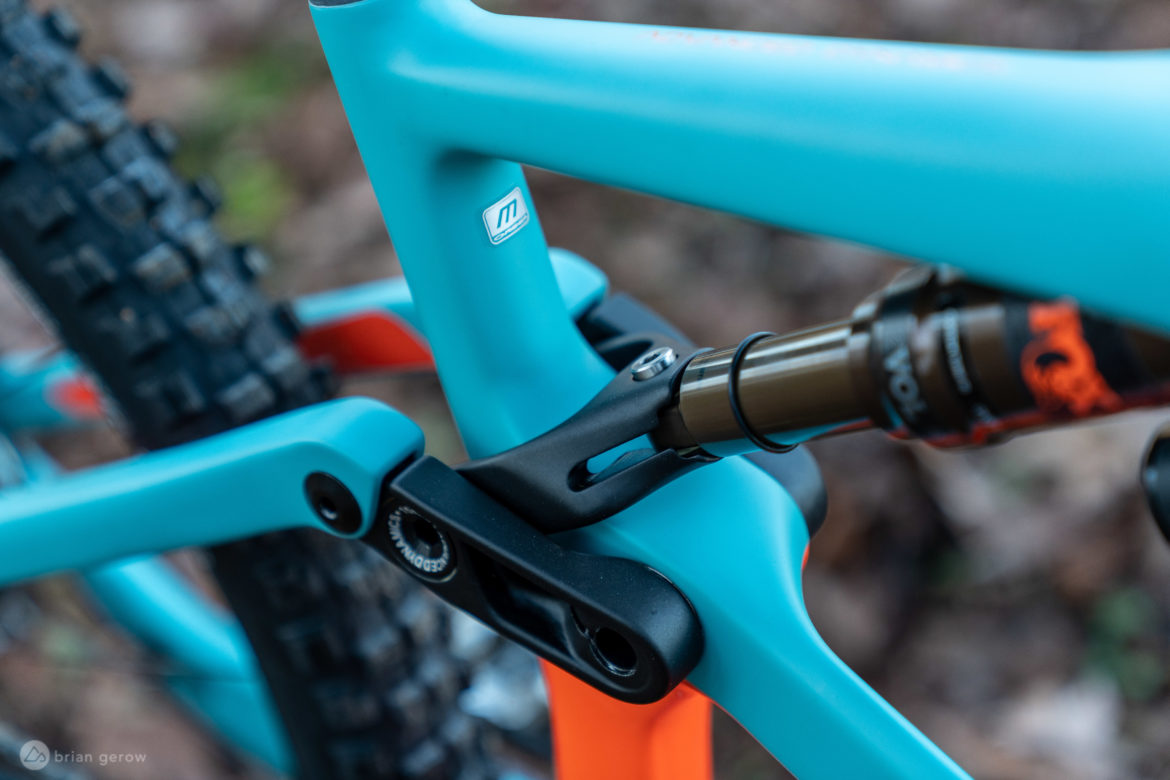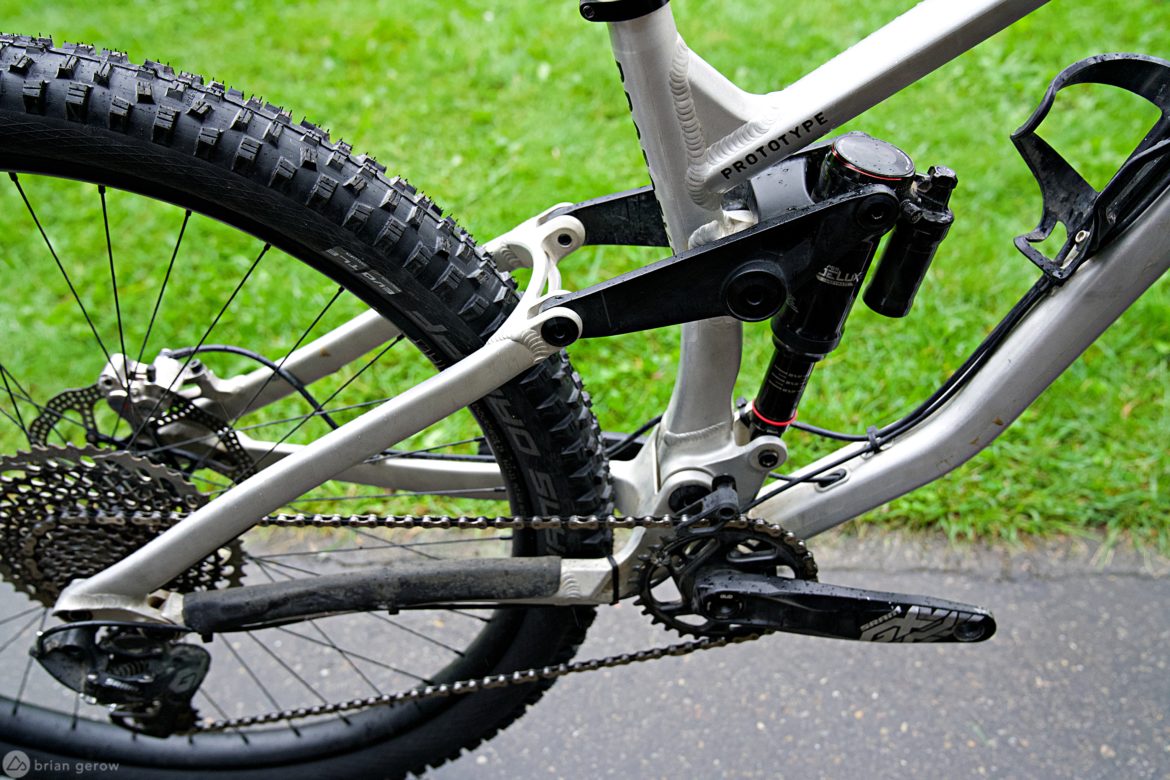
Why is the ceiling ten feet above the floor when the room’s inhabitants are rarely above seven feet tall? Architects consider myriad factors to create cozy spaces for humans. Things like natural lighting, furniture and fixture placement, future use cases, and what dimensions are necessary to make a person feel natural in their given culture.
Mountain bike frame engineers similarly account for a long list of characteristics and limitations when choosing shock length and stroke for a bike. What might appear to be a simple equation between the bike’s targeted rear travel measurement and two sturdy places to weld or mold shock mounts is actually quite complex. We contacted a number of frame engineers and shock specialists to find out how they select the right shock for their bikes.

First, in the name of clarity, lets define some key terms.
- Rear travel is a measurement of how far a bike’s rear axle moves as the suspension is compressed, also known as the rear axle path.
- Shock length is a measure of the distance between the eyes, or bolt holes, for a given shock.
- Shock stroke is a measurement of how far the shock shaft enters the shock body between full extension and full compression.
- Trunion refers to a compact shock mounting configuration that shortens the shock’s overall length by placing the mounts on the shock body itself.
- “Leverage ratio is simply the amount of rear wheel travel divided by the shock travel. On the Fuel EX for example, this is 130mm divided by 55mm of shock stroke. 130/55 = 2.363, which we’d write as 2.63:1 ratio. Leverage is the same a using a lever to lift a weight.” -Dylan Howes, Trek Bikes
- Suspension progressivity, in its simplest terms, describes the increasing rate of pressure required to compress a shock as the suspension system moves through its travel. A suspension platform’s level of progressivity is often discussed in relation to linear suspension which compresses with the same rate of force throughout the travel.

After deciding how much rear axle travel a bike should have, and determining whether they want it to have the riding characteristics of an XC, trail, enduro, downhill, or some other bike, engineers have to look at the other aesthetic and functional needs of the frame to determine where the shock mounts can go. If riders will want a water bottle, designers have to make space for it.
Some frame brands adhere to specific aesthetics that their engineers will consider when designing new bikes. For example, all modern frames from Kona and Transition maintain an open front triangle by using vertical shock placement, and both long travel whips from Orbea have asymmetrical bracing elements. Though these frame decisions are certainly not made based on looks alone, most brands are considering their bikes’ eye-candy appeal throughout the design process.
Once we know the amount of travel, then we typically will try to find the smallest size shock that will meet our range of ratios. We go for the smallest shock to keep the weight low, but also take into consideration how the shock will fit into the frame and allow for things like a low standover height, room for a water bottle, etc.
-Dylan Howes, Trek Bicycles
Then functional factors of the shock are also thrown into the mix before mount placement is finalized. Should the upper shock mount be under the top tube like a Commencal Meta AM29, on the down tube like a YT Capra, or does a vertical orientation work better with the suspension kinematic and other frame requirements? Which of those areas should be fortified and why?
How users will interact with the shock plays an additional role. All of the external adjustment knobs need to be accessible, as does the air valve. The latest Niner RIP 9 frame has a carbon brace on either side of the shock, requiring owners to use a special valve extender every time they want to check the air pressure in their shock. While this may not be an issue for folks who want to ride that bike, it is something the engineers had to consider. With the exception of the Gambler, all Scott full suspension bikes need to be able to use a handlebar-mounted compression lockout with their shocks, and engineers have to accommodate that element.

With all of the structural and kinematic forces factored, and the rider’s use cases considered, full suspension frame engineers also look through the shock length, stroke, tune, and mounting options available from the suspension companies that their brand has relationships with. Not all shock companies make the same array of sizes and fitments, and not every coil or air model will work with every leverage ratio or progression curve.
For Ruben Torenbeek of RAAW Mountain Bikes, “The average leverage ratio defines the basics for the suspension layout.” In rare form, the V2 Madonna frame can be set up with two different rocker links, and related shock strokes. “On the Madonna V2 we offer two different rocker links that create a low leverage ratio (1:2.46) and a high leverage ratio (1:2.67). The low ratio is better for heavier riders and the high ratio is better for light riders. We work with two [stroke] options, 205×60 and 205×65, each with their own rocker link, to generate 160mm of travel.”
Alistair Beckett of Redburn Designs is the mind behind an impressive list of full suspension designs, the most recent of which is the Privateer 161. Regarding the shock selection process, Beckett says “now that Metric has taken over as the latest shock sizing standard, most shock suppliers have a few stroke options within the same shock length (eye to eye). For the Privateer 161, if we wanted a stroke of around 65mm (64.4mm to be exact) we had the following options from SRAM: a 205×65 trunnion mount [or a] 230 x 65 regular mount/bearing mount. For reference, the 161 frame has a leverage rate starting at 2.62, falling to 2.64 at Sag, and ending at 2.17, which gives us the ‘ramp’ that this style of bike really benefits from.”
After choosing the shock length options for the bike, Beckett works with suspension engineers to create a shock tune that will optimize the bike’s suspension characteristics throughout its travel. “Once we had settled on the kinematics and overall layout, I communicated with Torben Borroway at SRAM to confirm the volume and tuning options that he thought would best suit the bike. I have done many shock tuning camps with Torben and I place full trust in his ability to always determine the best configuration for each frame. He always gets it right somehow!”

In some cases, bike suspension manufacturers’ decisions have a direct effect on what frame builders and engineers can do. Cy from Cotic Cycles shared a clear example of how industry standards have narrowed his shock choices and how he considers future shock length availability. “The main thing for me is getting the right balance of average leverage ratio to keep the shock in a good operating window, and the progression rate of the shock. Longer shocks are harder to package, and we have been driven from 200×57 to 230×62.5 on the move from RocketMAX Gen2 to RocketMAX Gen3 because most manufacturers aren’t making non-metric shocks anymore. We looked at 230mm for the Gen2 bike over 2 years ago, but at the time our main shock supplier wasn’t supporting 230×60 in all the options we needed so we went with 200×57 because it packaged easier for the progression rate we wanted at the time too. Two years later that’s changed, the design parameters of the bike changed a little, and we need to future-proof the bikes. It’s moved pretty quickly though, but mainly we have gone longer metric because that’s where the industry is going, and as a small player this is one area where we serve our customers best by following what the supply chain is doing.”
Frame engineers occasionally want to change their designs just a little. Trek Engineer Dylan Howes looked into some possible ways to make the 130mm Fuel EX more supple off the top as the model year rolled over to 2020. Since RockShox makes two sizes for each stroke measurement, Howes says “determining which of these two sizes or mounting styles to use depends on how the shock will fit in the frame, where within the frame we want the shock located and a host of other factors. That choice is harder to define and comes down to those factors listed along with others, and the engineer’s experience.
“On the Fuel EX, we chose the 210mm size standard as it allowed us to design a shock that could fit the Thru-Shaft packaging we wanted, but also allowed the shock to be swapped out for almost any other 210mm shock to give both us and the customer options on shock spec or choice.”

The sum of it
In short, the list of considerations between the floor and the ceiling, or the axle and the shock shaft, is as long as it is varied. The primary focus for any engineer is that the suspension works well throughout its range, but user interaction, aesthetics, shock availability, weight, and future shock standards all play significant roles in the overall design. While most of us won’t become bike frame engineers any time soon, we can all appreciate learning more about the machines that bring us exciting challenges and joy. We will continue to dig into more technical topics like this one, with an aim to demystify the squishy magic.



















